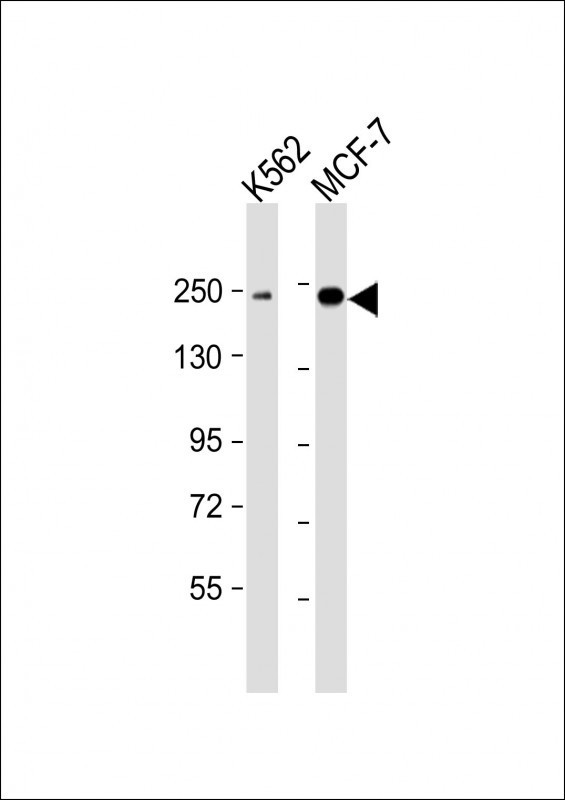XRN1 Antibody
Purified Mouse Monoclonal Antibody (Mab)
- SPECIFICATION
- CITATIONS
- PROTOCOLS
- BACKGROUND

Application
| WB, E |
|---|---|
| Primary Accession | Q8IZH2 |
| Reactivity | Human |
| Host | Mouse |
| Clonality | monoclonal |
| Isotype | IgG1,k |
| Clone/Animal Names | 1647CT723.27.62 |
| Calculated MW | 194107 Da |
| Gene ID | 54464 |
|---|---|
| Other Names | 5'-3' exoribonuclease 1, 3.1.13.-, Strand-exchange protein 1 homolog, XRN1, SEP1 |
| Target/Specificity | This XRN1 antibody is generated from a mouse immunized with arecombinant protein between1455-1706 amino acids from human XRN1. |
| Dilution | WB~~1:2000 E~~Use at an assay dependent concentration. |
| Storage | Maintain refrigerated at 2-8°C for up to 2 weeks. For long term storage store at -20°C in small aliquots to prevent freeze-thaw cycles. |
| Precautions | XRN1 Antibody is for research use only and not for use in diagnostic or therapeutic procedures. |
| Name | XRN1 (HGNC:30654) |
|---|---|
| Function | Major 5'-3' exoribonuclease involved in mRNA decay. Required for the 5'-3'-processing of the G4 tetraplex-containing DNA and RNA substrates. The kinetic of hydrolysis is faster for G4 RNA tetraplex than for G4 DNA tetraplex and monomeric RNA tetraplex. Binds to RNA and DNA (By similarity). Plays a role in replication-dependent histone mRNA degradation. May act as a tumor suppressor protein in osteogenic sarcoma (OGS). |
| Cellular Location | Cytoplasm. Note=Discrete foci at the inner surface of the cell membrane |
| Tissue Location | Expressed in heart, brain, pancreas, spleen, testis, osteogenic sarcoma (OGS) biopsy and primary cell lines |

Thousands of laboratories across the world have published research that depended on the performance of antibodies from Abcepta to advance their research. Check out links to articles that cite our products in major peer-reviewed journals, organized by research category.
info@abcepta.com, and receive a free "I Love Antibodies" mug.
Provided below are standard protocols that you may find useful for product applications.
Background
Major 5'-3' exoribonuclease involved in mRNA decay. Required for the 5'-3'-processing of the G4 tetraplex-containing DNA and RNA substrates. The kinetic of hydrolysis is faster for G4 RNA tetraplex than for G4 DNA tetraplex and monomeric RNA tetraplex. Binds to RNA and DNA (By similarity). Plays a role in replication-dependent histone mRNA degradation. May act as a tumor suppressor protein in osteogenic sarcoma (OGS).
References
Shimoyama Y.,et al.Neuroscience 121:899-906(2003).
Bechtel S.,et al.BMC Genomics 8:399-399(2007).
Ota T.,et al.Nat. Genet. 36:40-45(2004).
Sato Y.,et al.DNA Res. 5:241-246(1998).
Lejeune F.,et al.Mol. Cell 12:675-687(2003).
If you have used an Abcepta product and would like to share how it has performed, please click on the "Submit Review" button and provide the requested information. Our staff will examine and post your review and contact you if needed.
If you have any additional inquiries please email technical services at tech@abcepta.com.













 Foundational characteristics of cancer include proliferation, angiogenesis, migration, evasion of apoptosis, and cellular immortality. Find key markers for these cellular processes and antibodies to detect them.
Foundational characteristics of cancer include proliferation, angiogenesis, migration, evasion of apoptosis, and cellular immortality. Find key markers for these cellular processes and antibodies to detect them. The SUMOplot™ Analysis Program predicts and scores sumoylation sites in your protein. SUMOylation is a post-translational modification involved in various cellular processes, such as nuclear-cytosolic transport, transcriptional regulation, apoptosis, protein stability, response to stress, and progression through the cell cycle.
The SUMOplot™ Analysis Program predicts and scores sumoylation sites in your protein. SUMOylation is a post-translational modification involved in various cellular processes, such as nuclear-cytosolic transport, transcriptional regulation, apoptosis, protein stability, response to stress, and progression through the cell cycle. The Autophagy Receptor Motif Plotter predicts and scores autophagy receptor binding sites in your protein. Identifying proteins connected to this pathway is critical to understanding the role of autophagy in physiological as well as pathological processes such as development, differentiation, neurodegenerative diseases, stress, infection, and cancer.
The Autophagy Receptor Motif Plotter predicts and scores autophagy receptor binding sites in your protein. Identifying proteins connected to this pathway is critical to understanding the role of autophagy in physiological as well as pathological processes such as development, differentiation, neurodegenerative diseases, stress, infection, and cancer.


